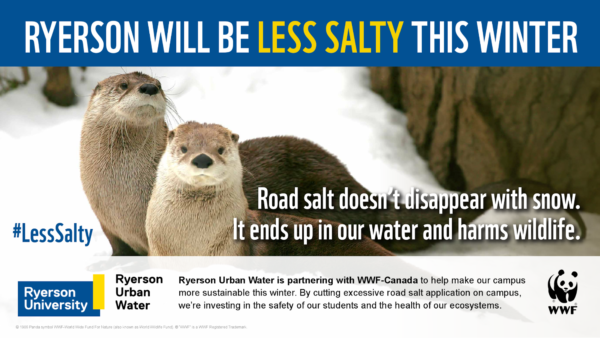Salt in the city: we need less of it

As Canada heads into summer, road salt is probably one of the last things on your mind. It might no longer be on our parking lots, roads and sidewalks, but the de-icing road salt that keeps us safe in the winter is still present in our creeks and rivers — that’s bad news for our freshwater wildlife and ecosystems.
WWF-Canada recently published our Great Lakes Hot Spot Maps, which highlight the devastating effects of chloride levels due to excessive road salt on species like fish, frogs and mussels in many southern Ontario urban and rural waterways. Some waterways are even as salty as the ocean at their peaks.
The good news is that solutions to balance public safety and environmental health are possible. Ryerson Urban Water (RUW) and Ryerson Facilities Management and Development (FMD) recently collaborated with WWF-Canada on a unique project to optimize the application of road salts to create safe public spaces, while cutting excessive salts that would otherwise harm the environment.
Over the 2018-2019 winter, the FMD team created an in-house liquid brine solution (a mixture of salt and water) to de-ice up to 20 locations across Ryerson’s downtown campus. Throughout the process, research lead Dr. Claire Oswald and her team tracked the effectiveness, cost benefits and reduction in road salt usage.
“Applying liquid brine resulted in a faster and more efficient method of de-icing. We reduced the amount of salt needed to achieve bare pavement on our walkways and roadways by 20-60 per cent, resulting in less wear on both our machinery and our staff, and a cost savings in materials applied,” says
Daniel Batko, Supervisor Custodial and Ground Services.
Preliminary results found that almost 4000 kg of sodium chloride (road salt mass) has been diverted from the Ryerson campus as a result of brine application—a reduction of approximately 200 fewer 20kg bags of salt. More importantly, the brine did not compromise pedestrian safety around campus during the winter. Researchers found that on average, the brine application required 25 per cent less road salt.
“The simplest way to mitigate the effects of chloride is to reduce the amount of road salt we apply on our roads and sidewalks, which was achieved through anti-icing brine technology. The data will help us scale up these results to other properties around the city,” says Dr. Claire Oswald, Research lead.
After their successful pilot, the team is currently developing plans for this coming winter when Ryerson will apply the brine treatment over a larger area. The researchers are also working closely with WWF-Canada to engage different sectors in the potential benefits of brine usage in areas such as TTC stations, Metrolinx GO stations, and Green P parking lots.

This project illustrates the importance of supporting collaborations like the one with Ryerson University, to come up with better management practices to protect wildlife and ecosystems. Being #LessSalty is a great way to both benefit our communities and our freshwater wildlife and ecosystems.
To learn more about this project, click here.

